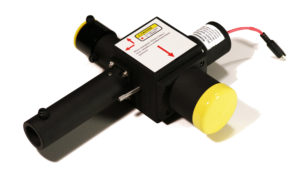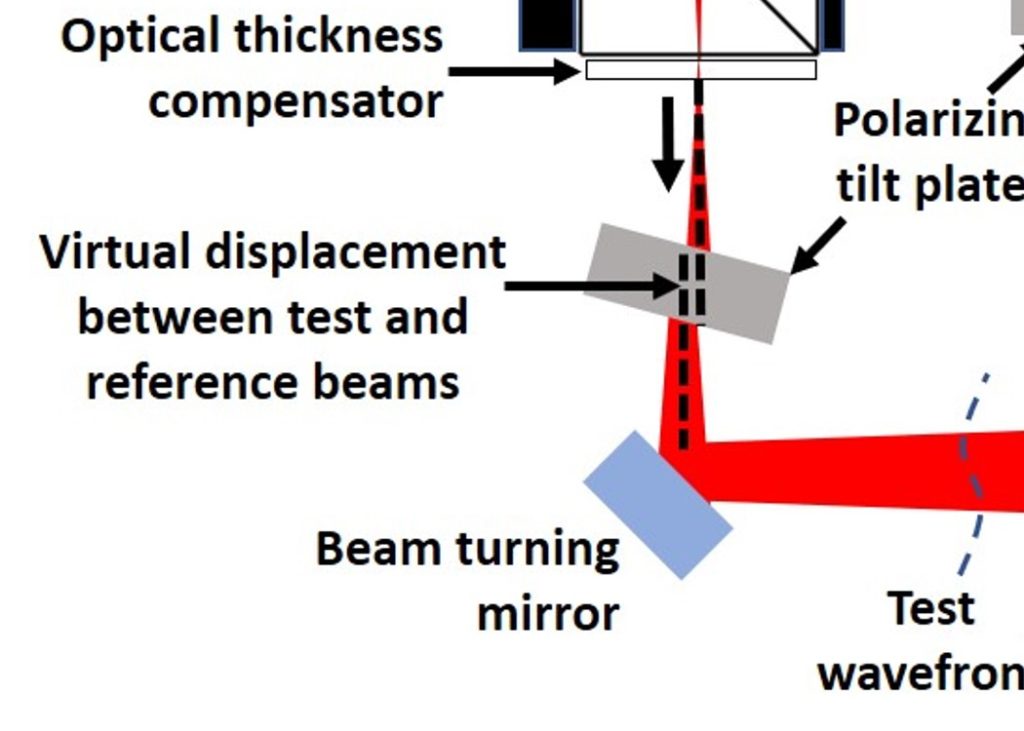

Our flagship product is our SPPDI Model 1 Series ultra compact general purpose laser optical interferometers. SPPDI is an acronym for Split-path Point Diffraction Interferometer. The SPPDI is a patented extension of the Point Diffraction Interferometer (PDI) as described in 1972 by Dr. Raymond N. Smartt of the University of Massachusetts. (Reference R. N. Smartt and J. Strong, JOSA, 62, 737, 1972.)
In a Smartt-style PDI, interference fringe spacing and fringe visibility (contrast) are coupled, which reduces operational practicality. The SPPDI introduces additional optical components in the internal beam path to separate this coupling, greatly improving the available range for fringe spacing and fringe visibility (i.e., fringe contrast or dynamic range).

The SPPDI emits a diffraction-limited probe beam that is precisely co-axial with the optical axis of the test article. This makes it possible to measure optical components or systems with short focal lengths.
The SPPDI reference beam is generated internally within the SPPDI by splitting off a portion of the test beam returned by the test article. This portion of the test beam is spatially filtered by a small pinhole aperture, thus generating a spherical reference wavefront, which remains co-axial with the test beam.
Interference fringes are produced by means of a pair of polarizing tilt plates, either or both of which may be adjusted by the user to cause a displacement between the test and reference beams, as shown in the figure below.

As can be seen in the figure, a virtual separation between the test beam and the reference beam is produced by tilting one or both of the tiltable, rotatable polarizers located inside the SPPDI enclosure. This enables an apparent separation between the diverging test and reference beams, thus generating interference fringes whose spacing and contrast are easily adjusted by the user. The tilt of the internal polarizers does introduce a small amount (typically <0.01 wave at 650 nm) of astigmatism, which is proportional to the tilt and the number of interference fringes. A simple equation is available (see the following section) to facilitate computation of the astigmatism, which is usually insignificant compared to astigmatism caused by environmental disturbances such as air currents.
The SPPDI is capable of directly measuring test beams as “fast” as f/4. For example, an f/2 concave spherical or aspheric mirror may be directly measured at its f/4 center of curvature. Measurement of test beams with focal ratios in the range f/4 to f/10 must be accompanied by measurement of a high precision reference sphere (available from Kerry Optical Systems) to produce a correction wavefront. For test beams with “slower” focal ratios of f/10 or more the compact optical design of the SPPDI and small beam footprint on the various internal optical components reduce the impact of instrumental errors to a negligible level.
The compact size and sturdiness of the SPPDI enclosure helps ensure that the critical alignment of the internal signal and reference beam paths are maintained when exposed to the ambient environment. We are confident that the operational benefits and simplicity of operation of the SPPDI outweigh the added complexity, while retaining the core elegance and simplicity of the original PDI concept.
For a full description of the SPPDI, refer to the SPPDI patent document (United States Patent # US005457533d, now expired), which can be found at the United States Patent Office website: www.uspto.gov. A full description of the SPPDI is given in the SPPDI® Model 1 Series Device User Manual.
![]()
